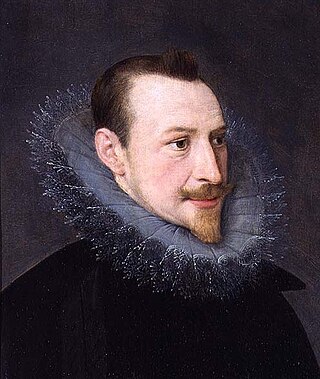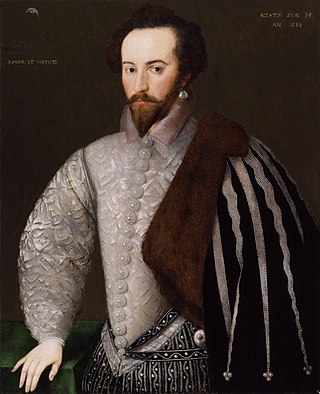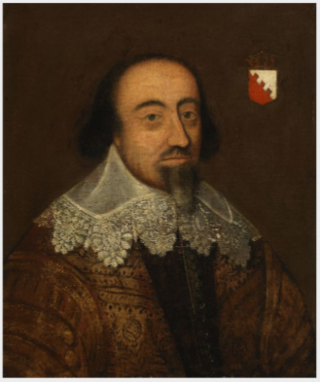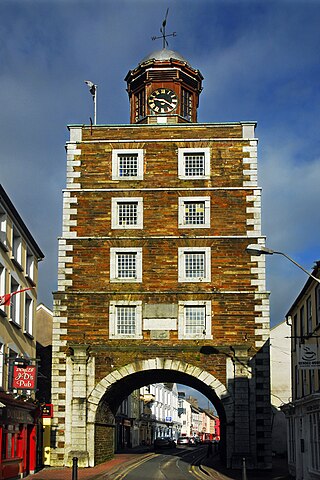
Myrtle Grove is an Elizabethan gabled house in Youghal, County Cork, Ireland. The house is notable as a rare example in Ireland of a 16th-century unfortified house. It is situated close to the Collegiate Church of St Mary Youghal. [1]

Myrtle Grove is an Elizabethan gabled house in Youghal, County Cork, Ireland. The house is notable as a rare example in Ireland of a 16th-century unfortified house. It is situated close to the Collegiate Church of St Mary Youghal. [1]

It was home for Sir Walter Raleigh from 1588 to 1589. Myrtle Grove's South Gable is where Edmund Spenser is reputed to have written part of his poem The Faerie Queene , although some historians question this story. [2] The house was acquired by Richard Boyle, 1st Earl of Cork in 1602 from Sir Walter Raleigh's Irish estate. Boyle leased it to his protege Sir Lawrence Parsons, the judge of the Irish Admiralty Court. Though remodelled twice it remains one of the best-known examples of a Tudor house in Ireland. [3] The house was acquired by the Hayman family in the 18th century. [4] [5]
In the 20th century, it was the home of Sir Henry Arthur Blake and Lady Blake. At this time, the building housed "the best collection of West Indian paintings and sketches". [6] The Blakes lived here until their deaths. They were buried in the garden. [7]
The house remains in private ownership and is closed to the public.
The house is reputed to be where potatoes were first planted in Ireland or in Europe. [8] The latter is unlikely, however, as potatoes were present only in Spain in 1536. There is a similar legend stating that Myrtle Grove was where tobacco was first smoked by Walter Raleigh. [8]
"Myrtle Grove", a poem written in Spenserian stanzas by James Reiss, and published in Fugue magazine (the University of Idaho) in 2007, develops the legend that Edmund Spenser wrote portions of his great epic, The Faerie Queene, under an aureole window in the South Gable of Raleigh's house. [9]

Edmund Spenser was an English poet best known for The Faerie Queene, an epic poem and fantastical allegory celebrating the Tudor dynasty and Elizabeth I. He is recognized as one of the premier craftsmen of nascent Modern English verse and is often considered one of the greatest poets in the English language.

Sir Walter Raleigh was an English statesman, soldier, writer and explorer. One of the most notable figures of the Elizabethan era, he played a leading part in English colonisation of North America, suppressed rebellion in Ireland, helped defend England against the Spanish Armada and held political positions under Elizabeth I.

Richard Boyle, 1st Earl of Cork, also known as the Great Earl of Cork, was an English politician who served as Lord Treasurer of the Kingdom of Ireland.

The Faerie Queene is an English epic poem by Edmund Spenser. Books I–III were first published in 1590, then republished in 1596 together with books IV–VI. The Faerie Queene is notable for its form: at over 36,000 lines and over 4,000 stanzas, it is one of the longest poems in the English language; it is also the work in which Spenser invented the verse form known as the Spenserian stanza. On a literal level, the poem follows several knights as a means to examine different virtues, and though the text is primarily an allegorical work, it can be read on several levels of allegory, including as praise of Queen Elizabeth I. In Spenser's "Letter of the Authors", he states that the entire epic poem is "cloudily enwrapped in Allegorical devices", and that the aim of publishing The Faerie Queene was to "fashion a gentleman or noble person in virtuous and gentle discipline".
The Spenserian stanza is a fixed verse form invented by Edmund Spenser for his epic poem The Faerie Queene (1590–96). Each stanza contains nine lines in total: eight lines in iambic pentameter followed by a single 'alexandrine' line in iambic hexameter. The rhyme scheme of these lines is ABABBCBCC.

Youghal is a seaside resort town in County Cork, Ireland. Located on the estuary of the River Blackwater, the town is a former military and economic centre. Located on the edge of a steep riverbank, the town has a long and narrow layout. As of the 2022 census, the population was 8,564.

Castlemartyr is a large village in County Cork, Ireland. It is around 30 kilometres (19 mi) east of Cork city, 10 km (6 mi) east of Midleton, 16 km (10 mi) west of Youghal and 6 km (4 mi) from the coast. Approximately 1,600 people live in the village and its hinterland. It is situated on the N25 national primary road and the R632 regional road.
Belphoebe is a character in Edmund Spenser's poem The Faerie Queene (1590), a representation of Queen Elizabeth I. Spenser intended her name to mean "beautiful Diana", and it is suggested that she is a member of Poseidon's family. A virgin huntress, Belphoebe can certainly fight, as a potential rapist found out. She is the stronger, militant sister of Amoret.

Arenig Fawr is a mountain in Snowdonia, North Wales, close to Llyn Celyn reservoir, alongside the A4212 between Trawsfynydd and Bala.
Nationality words link to articles with information on the nation's poetry or literature.

The Collegiate Church of Saint Mary the Virgin, also known as St Mary's Collegiate Church, is a large Anglican church in Youghal, east County Cork, Ireland. Dating to roughly 1220 and dedicated to the Virgin Mary, it is part of Youghal Union of Parishes, in the United Dioceses of Cork, Cloyne and Ross.

In the Middle Ages, a palmer was a Christian pilgrim, normally from Western Europe, who had visited the holy places in Palestine and who, as a token of his visits to the Holy Land, brought back a palm leaf or a palm leaf folded into a cross. Palmers were often highly regarded as well-natured holy men because of their devotion to Christ along the pilgrimage. The word is frequently used as synonymous with "pilgrim".
— From Sir John Harington, A New Discourse of a Stale Subject, called the Metamorphosis of Ajax

Colin Clouts Come Home Againe is a pastoral poem by the English poet Edmund Spenser and published in 1595. It has been the focus of little critical attention in comparison with the poet's other works such as The Faerie Queene, yet it has been called the "greatest pastoral eclogue in the English language". In a tradition going back to Petrarch, the pastoral eclogue contains a dialogue between shepherds with a narrative or song as an inset, and which also can conceal allegories of a political or ecclesiastical nature.
There have been two baronetcies created for persons with the surname Tynte, one in the Baronetage of England and one in the Baronetage of Ireland. Both are extinct.

Tivoli is an eastern suburb of Cork in Ireland. Tivoli is in the Dáil constituency of Cork North-Central. A station on the former Cork and Youghal Railway served the area between the 1860s and 1930s.

The River Bride is a river in counties Cork and Waterford in Ireland. It is a tributary of the Munster Blackwater. Rising in the Nagle Mountains, it flows eastward, passing through the towns of Rathcormac, Castlelyons, Conna and Tallow, before joining the Blackwater at Camphire, approximately 3 miles (4.8 km) north of Youghal. The English poet Edmund Spenser is reputed to have written part of his poem "The Faerie Queene" on the banks of the Bride in the Conna area. The river runs through the baronies of Barrymore and Imokilly. The river is tidal up to Tallow Bridge.
Lodowick Bryskett, was a poet, translator, diplomat and Irish official. He served as Special Ambassador from England to Tuscany in 1600-01.

Patricia Cockburn was an Irish writer, traveler, conchologist and artist. She was best known for her journalism and her later artistic career, creating shell pictures.

The Red House is an 18th-century William and Mary style house located in Youghal, Ireland.
{{cite book}}: CS1 maint: location missing publisher (link)